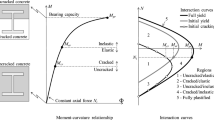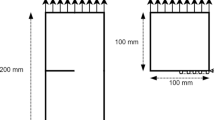Abstract
Object of the paper is the simulation of reinforced concrete bars behaviour, accounting for crack opening and concrete-rebar slippage. A macro beam element with a single uniform reinforcement is studied in details in the uniaxial case. Distinct constitutive hypotheses are formulated for the materials. The CEB-FIP Model Code 90 rules the behaviour of the materials interface that is assumed to be fully dissipative. Steel is supposed to behave elastoplastically with hardening. Crack opening in the concrete matrix is introduced by means of a strong discontinuity approach (SDA). All the relevant equations of the problem are variationally derived from a mixed energy functional. Two enhancements of the enriched kinematics, based on polynomial or exponential shape functions, respectively, are compared with the usual SDA enhancement. As an alternative approach, high-order interpolation of the displacement field based on B-splines, both for steel and concrete, is proposed. These functions appear to be adequate in reproducing rapidly varying fields, like the stress gradients occurring in the shear lag problem near the boundaries or where slips and/or cracks occur. Their use allow to use few macro-element instead of the very dense meshing required in those areas by the traditional FE interpolations.
Similar content being viewed by others
References
Alfaiate J, Simone A, Sluys L (2003) Non-homogeneous displacement jumps in strong embedded discontinuities. Int J Solids Struct 40: 5799–5817
Auricchio F, Beirão da Veiga L, Buffa A, Lovadina C, Reali A, Sangalli G (2007) Isogeometric finite element data structures based on bzier extraction of nurbs. Comput Methods Appl Mech Eng 197: 160–172
Ayala G, Contrafatto L, Cuomo M, Retama J (2010) Consistent symmetric formulation of the enhanced embedded discontinuity method. In: IV European conference on computational mechanics
Barenblatt GI (1962) The mathematical theory of equilibrium cracks in brittle fracture. Adv Appl Mech 7: 55–129
Becker G, Noels L (2011) A fracture framework for euler-bernouilli beams based on a full discontinuous Galerkin formulation/extrinsic cohesive law combination. Int J Numer Methods Eng 85: 1227–1251
Belytschko T, Moës N, Usui S, Parimi C (2001) Arbitrary discontinuities in finite elements. Int J Numer Methods Eng 50: 993–1013
Benson D, Bazilevs Y, Hsu MC, Hughes TJR (2011) A large deformation, rotation free, isogeometric shell. Comput Methods Appl Mech Eng 200: 1367–1378
Borden MJ, Scott MA, Evans KA, Hughes TJR (2011) Isogeometric finite element data structures based on bzier extraction of nurbs. Int J Numer Methods Eng 87: 15–47
Caballero A, Carol I, López CM (2007) 3D meso-mechanical analysis of concrete specimens under biaxial loading. Fatigue Fract Eng Mater Struct 30(9): 877–886
CEB-FIP: Model Code 90. Thomas Telford Ltd, 1993
Chudoba R, Jerabek J, Peiffer F (2009) Crack-centered enrichment for debonding in two-phase composite applied to textile reinforced concrete. Int J Multiscale Comput Eng 7(4): 309–328
Choi CK, Kim KH, Hong HS (2002) Spline finite strip analysis of prestressed concrete box-girder bridges. Eng Struct 24: 1575–1586
Ciancio D, Carol I, Cuomo M (2007) Crack opening conditions at corner nodes in FE analysis with cracking along mesh lines. Eng Fract Mech 74: 1963–1982
De Luycker E, Benson D, Belytschko T, Bazilevs Y, Hsu M (2011) X-FEM in isogeometric analysis for linear fracture mechanics. Int J Numer Methods Eng 87: 541–565
Dias-da Costa D, Alfaiate J, Sluys L, Júlio E (2009) Towards a generalization of a discrete strong discontinuity approach. Comput Methods Appl Mech Eng 198: 3670–3681
Dias-da Costa D, Alfaiate J, Sluys L, Júlio E (2010) A comparative study on the modeling of discontinuous fracture by means of enriched nodal and element techniques and interface elements. Int J Fract 161: 97–119
Dugdale DS (1960) Yielding of steel sheets containing slits. J Mech Phys Solids 8(2): 100–104
Eve R, Reddy B, Rockafellar R (1990) An internal variable theory of elastoplasticity based on the maximum plastic work inequality. Quart Appl Math 48: 59–83
Huang H, Costanzo F (2004) On the use of space-time finite elements in the solution of elasto-dynamic fracture problems. Int J Fract 127(2): 119–146
Ibrahimbegovic A, Boulkertous A, Davenne L, Brancherie D (2010) Modelling of reinforced-concrete structures providing crack-spacing based on X-FEM, ED-FEM and novel operator split solution procedure. Int J Numer Methods Eng 83: 452–481
Jirásek M, Zimmermann T (2001) Embedded crack model: part i: basic formulation. Int J Numer Methods Eng 50: 1269–1290
Keuser M, Mehlhorn G (1987) Finite element models for bond problems. J Struct Eng 113: 2160–2173
Kiendl J, Bletzinger K, Linhard J, Wuchner R (2009) Isogeometric shell analysis with Kirchhoff-Love elements. Comput Methods Appl Mech Eng 198: 3902–3914
Lachner R, Mang H (2003) Scale transition in steel–concrete interaction. I: model. J Eng Mech ASCE 129(4): 393–402
Liao K, Reifsnider L (2000) A tensile strength model for unidirectional fiber-reinforced brittle matrix composite. Int J Fract 106: 95–115
Linder C, Armero F (2007) Finite elements with embedded strong discontinuities for the modeling of failure in solids. Int J Numer Methods Eng 72: 1391–1433
Moës N, Dolbow I, Belytschko T (1999) A finite element method for crack growth without remeshing. Int J Numer Methods Eng 46: 131–150
Mosler J (2005) A novel algorithmic framework for the numerical implementation of locally embedded strong discontinuities. Comput Methods Appl Mech Eng 194: 4731–4757
Newmark NM, Siess CP, Viest IM (1951) Tests and analysis of composite beams with incomplete interaction. In: Proceedings of society for experimental stress analysis, vol 9, pp 75–92
Oliver J (1996) Modelling of strong discontinuities in solid mechanics via strain softening constitutive equations. Part 1: fundamentals. Part 2: numerical simulation. Int J Numer Methods Eng 39(21): 3575–3623
Ortiz M, Leroy Y, Needleman A (1987) A finite element method for localized failure analysis. Comput Methods Appl Mech Eng 61: 189–214
Oliver J, Cervera M, Manzoli O (1999) Strong discontinuities and continuum plasticity models: the strong discontinuity approach. Int J Plast 15: 319–351
Oliver J, Huespe A, Snchez P (2006) A comparative study on finite elements for capturing strong discontinuities: E-FEM vs. X-FEM. Comput Methods Appl Mech Eng 195: 4732–4752
Oliver J, Linero D, Huespe A, Manzoli O (2008) Two-dimensional modeling of material failure in reinforced concrete by means of a continuum strong discontinuity approach. Comput Methods Appl Mech Eng 197: 332–348
Prasad M, Krishnamoorthy C (2002) Computational model for discrete crack growth in plain and reinforced concrete. Comput Methods Appl Mech Eng 191: 2699–2725
Prechtel M, Leiva Ronda P, Janish R, Hartmaier A, Leugering G, Steinmann P, Stingl M (2011) Simulation of fracture in heterogeneous elastic materials with cohesive zone models. Int J Fract 168: 15–29
Radtke F, Simone A, Sluys L (2011) A partition of unity finite element method for simulating non-linear debonding and matrix failure in thin fibre composites. Int J Numer Methods Eng 86: 453–476
Rockafellar R (1970) Convex analysis. Princeton University Press, Princeton, NJ
Simo JC, Oliver J (1994) A new approach to the analysis and simulation of strain softening in solids. In: Bažant ZP, Bittnar Z, Jirásek M, Mazars J (eds) Fracture and damage in quasi-brittle structures. E&FN Spon, London, pp 25–39
Simo J, Oliver J, Armero F (1993) An analysis of strong discontinuities induced by strain softening in rate independent inelastic solids. Comput Mech 12: 277–296
Verhoosel C, Scott M, de Borst R, Hughes TJR (2011) An isogeometric approach to cohesive zone modeling. Int J Numer Methods Eng 87: 336–360
Author information
Authors and Affiliations
Corresponding author
Rights and permissions
About this article
Cite this article
Contrafatto, L., Cuomo, M. & Fazio, F. An enriched finite element for crack opening and rebar slip in reinforced concrete members. Int J Fract 178, 33–50 (2012). https://doi.org/10.1007/s10704-012-9723-1
Received:
Accepted:
Published:
Issue Date:
DOI: https://doi.org/10.1007/s10704-012-9723-1




